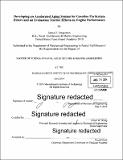| dc.contributor.advisor | Victor W. Wong | en_US |
| dc.contributor.author | Jorgensen, James E. (James Eastman) | en_US |
| dc.contributor.other | Massachusetts Institute of Technology. Department of Mechanical Engineering. | en_US |
| dc.date.accessioned | 2014-12-08T18:51:28Z | |
| dc.date.available | 2014-12-08T18:51:28Z | |
| dc.date.copyright | 2014 | en_US |
| dc.date.issued | 2014 | en_US |
| dc.identifier.uri | http://hdl.handle.net/1721.1/92137 | |
| dc.description | Thesis: S.M. in Naval Architecture and Marine Engineering, Massachusetts Institute of Technology, Department of Mechanical Engineering, 2014. | en_US |
| dc.description | Cataloged from PDF version of thesis. | en_US |
| dc.description | Includes bibliographical references (pages 79-81). | en_US |
| dc.description.abstract | Stringent regulations worldwide will limit the level of particulate matter (PM) emitted from gasoline engines equipped with direct fuel injection. Gasoline particulate filters (GPFs) present one strategy for meeting PM limits over the full operating range of the engine. Over time these filters accumulate incombustible ash, increasing system pressure drop and adversely effecting engine performance. The effect of aging as a result of ash accumulation is examined over the full lifetime of gasoline particulate filters, using a novel accelerated aging system. This system utilizes a gasoline combustion chamber into which lubricating oil is injected simulating combustion in the power cylinder - the primary source of lubricant-derived ash. Advanced imaging techniques are used to characterize filter and particulate emission behavior, and compare to prior data from diesel filters of the same type. Likewise, pressure drop behavior is observed for multiple filter samples and compared to prior experiments. A collocated Gasoline Direct Injection engine was installed for comparative purposes; a method of testing engine performance with GPF installations was developed and the engine was prepared and instrumented for future testing. This report details the construction and validation of the accelerated aging system, examination and comparison of results to those from prior experiments, and confirmation of principal assumptions used in developing the experimental test matrix. This study is one of a very few completed in a unique, emerging field of study, driven by new and extremely stringent emissions regulations around the globe. Practical testing here lays the foundation for future detailed research into the behavior and application of particulate filters to gasoline fueled engines in light duty passenger vehicles. | en_US |
| dc.description.statementofresponsibility | by James E. Jorgensen. | en_US |
| dc.format.extent | 88 pages | en_US |
| dc.language.iso | eng | en_US |
| dc.publisher | Massachusetts Institute of Technology | en_US |
| dc.rights | M.I.T. theses are protected by copyright. They may be viewed from this source for any purpose, but reproduction or distribution in any format is prohibited without written permission. See provided URL for inquiries about permission. | en_US |
| dc.rights.uri | http://dspace.mit.edu/handle/1721.1/7582 | en_US |
| dc.subject | Mechanical Engineering. | en_US |
| dc.title | Developing an accelerated aging system for gasoline particulate filters and an evaluation test for effects on engine performance | en_US |
| dc.type | Thesis | en_US |
| dc.description.degree | S.M. in Naval Architecture and Marine Engineering | en_US |
| dc.contributor.department | Massachusetts Institute of Technology. Department of Mechanical Engineering | |
| dc.identifier.oclc | 896166315 | en_US |
